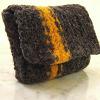That’s right, today is the 40th annual Earth Day. While I think that environmental awareness warrants more than 1 calendar day a year, it’s a good day to think about our priorities and lifestyles and see where we can make an improvement.
Knitters already understand the value of making something yourself by hand instead of buying the cheap imported alternative, but here’s a look at how we can reduce, reuse and recycle even more.
 Reduce our yarn stash, never! But we can reduce the use of pesticides, virgin materials, and synthetic fibers in our yarn. Step one: look for natural fibers like cotton, wool, alpaca, bamboo, linen, flax, soy, tencel, hemp, plant fiber, angora or cashmere. These come from natural sources. Avoid fibers like acrylic, polyamide, acetate, nylon, and microfiber. These are all man made (read: petroleum based) fibers. Natural fibers are more expensive, but they made for a much nicer finished product.
Reduce our yarn stash, never! But we can reduce the use of pesticides, virgin materials, and synthetic fibers in our yarn. Step one: look for natural fibers like cotton, wool, alpaca, bamboo, linen, flax, soy, tencel, hemp, plant fiber, angora or cashmere. These come from natural sources. Avoid fibers like acrylic, polyamide, acetate, nylon, and microfiber. These are all man made (read: petroleum based) fibers. Natural fibers are more expensive, but they made for a much nicer finished product.
Here are some other symbols to look for when choosing yarn:
 FSC – the Forest Stewardship Council certifies forests that are responsibly managed and replanted. When you see this symbol on your yarn, you can be sure that the fibers used to make it were harvested correctly.
FSC – the Forest Stewardship Council certifies forests that are responsibly managed and replanted. When you see this symbol on your yarn, you can be sure that the fibers used to make it were harvested correctly.
 Organic – The U.S. Department of Agriculture regulates what can and can’t be called organic. When you buy organic yarn you’re supporting farmers that grow their crops without petroleum based pesticides and fertilizers. It’s better for the surrounding water supply and it’s better for the farmers that produce the crops and their families that live on the farms.
Organic – The U.S. Department of Agriculture regulates what can and can’t be called organic. When you buy organic yarn you’re supporting farmers that grow their crops without petroleum based pesticides and fertilizers. It’s better for the surrounding water supply and it’s better for the farmers that produce the crops and their families that live on the farms.
 Fair trade certified. This is one people don’t talk about as often, but it’s one of the most important. In a global economy like ours, a lot of the products we use, including yarn and fibers, are imported from other countries. Fair trade certified products mean that the artisans that make those products are paid a fair wage for their craft and not exploited. Fair trade websites like thehungersite.com sell yarns, but if you look around at your local yarn shops and craft fairs your likely to find fair trade products. And if you don’t, go ahead and ask about them, they may be happy to source them for you. It feels great to support other artisans like yourself.
Fair trade certified. This is one people don’t talk about as often, but it’s one of the most important. In a global economy like ours, a lot of the products we use, including yarn and fibers, are imported from other countries. Fair trade certified products mean that the artisans that make those products are paid a fair wage for their craft and not exploited. Fair trade websites like thehungersite.com sell yarns, but if you look around at your local yarn shops and craft fairs your likely to find fair trade products. And if you don’t, go ahead and ask about them, they may be happy to source them for you. It feels great to support other artisans like yourself.
![]() Think local. It makes sense, when you buy locally made yarn, you’re supporting agriculture in your community and reducing the amount of fuel needed to transport it. Alpaca farms are popular across the country and many make and sell their own yarn. Check your local co-op or agri-tourism website to see if anyone in your area makes yarn.
Think local. It makes sense, when you buy locally made yarn, you’re supporting agriculture in your community and reducing the amount of fuel needed to transport it. Alpaca farms are popular across the country and many make and sell their own yarn. Check your local co-op or agri-tourism website to see if anyone in your area makes yarn.
 Reuse – I’ve seen all kinds of ingenious ideas ideas for reusing things like t-shirts, plastic bags, and even newspaper into yarn. Here are links to a few tutorials:
Reuse – I’ve seen all kinds of ingenious ideas ideas for reusing things like t-shirts, plastic bags, and even newspaper into yarn. Here are links to a few tutorials:
http://greenupgrader.com/2138/handspun-recycled-newspaper-yarn/
http://www.craftpassion.com/2009/05/recycle-tutorial-making-of-t-shirt-yarn.html
And, let’s not forget – good old fashioned frogging. Visit your local thrift store and find an ugly sweater made of beautiful yarn and start unraveling. You can wind it onto a spool or into balls and let it air for a few days then start recreating. This is probably the cheapest and greenest way to find beautiful yarn. The thrift store is also a great source for purse handles, buttons, and other notions.
 I’m starting to find a lot of great recycled options in the yarn aisle. From recycled cotton to wools and silks, this is a great way to support the recycling industry. It’s great to recycle, but unless we buy recycled products, there won’t be any incentive for people to keep doing it. Here are a few ideas on how to recycle your own leftovers:
I’m starting to find a lot of great recycled options in the yarn aisle. From recycled cotton to wools and silks, this is a great way to support the recycling industry. It’s great to recycle, but unless we buy recycled products, there won’t be any incentive for people to keep doing it. Here are a few ideas on how to recycle your own leftovers:
 Gift wrapping. I love the idea of using the leftovers from a knitted gift to wrap it. It’s like giving them a little sneak peak of what’s inside.
Gift wrapping. I love the idea of using the leftovers from a knitted gift to wrap it. It’s like giving them a little sneak peak of what’s inside.
Pom Poms. Tie them onto a tree branch in a pretty vase, string them together and decorate a kid’s room, or just use them to drive your pets crazy.
Knit a small square to add to a patchwork charity quilt.
Or, just donate them to a friend with kids or a local school or camp. It’s amazing how many craft projects they can come up with to use them.
 Well that’s it. Happy Earth day to everyone! Let’s all make a small change to make the planet a better place to live.
Well that’s it. Happy Earth day to everyone! Let’s all make a small change to make the planet a better place to live.


 Where I'm at
Where I'm at Beach Bum Bag
Beach Bum Bag Garter Snake Purse
Garter Snake Purse Head to Headband
Head to Headband Holy Cowl!
Holy Cowl! Holy Cuffs
Holy Cuffs Organic Mushrom
Organic Mushrom Racing Stripes
Racing Stripes Silk Bandana Scarf
Silk Bandana Scarf The Eco Hero
The Eco Hero The Kiwi Slouch
The Kiwi Slouch The Micro Scarf
The Micro Scarf The Weekender
The Weekender
1 Comment